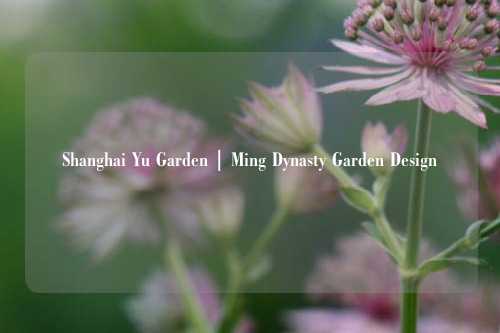Shanghai Yu Garden | Ming Dynasty Garden Design
Shanghai Yu Garden is one of the most well-preserved classical gardens in China, reflecting the artistry and elegance of Ming Dynasty landscape design. Located in the bustling heart of Shanghai, it serves as a sanctuary of tranquility amidst the city’s modern development. With its intricate layout of pavilions, rockeries, ponds, and winding corridors, Yu Garden offers visitors an opportunity to experience the aesthetic principles that shaped traditional Chinese garden architecture.
The Historical Origins of Yu Garden
Yu Garden was originally built during the Ming Dynasty in the 16th century by Pan Yunduan, a government official who wanted to create a peaceful retreat for his aging parents. The name "Yu" translates to "peace and comfort," encapsulating the purpose behind its creation. The garden took nearly two decades to complete and was influenced by classical Jiangnan-style gardens, which emphasize harmony between natural elements and human-made structures.

Throughout its history, Yu Garden underwent periods of neglect and restoration. During the Qing Dynasty, it was revitalized by local merchants, and later in the 20th century, extensive efforts were made to preserve its original beauty. Despite the many changes Shanghai has undergone over the centuries, Yu Garden remains a cherished landmark, offering insight into the refined aesthetics of ancient Chinese scholars and aristocrats.
The Architectural Elegance of Yu Garden
The layout of Yu Garden follows the core principles of traditional Chinese garden design, creating a seamless blend of architecture, water features, rock formations, and plant life. Unlike Western-style gardens that emphasize open, symmetrical landscapes, Chinese gardens like Yu Garden are designed to create a series of interconnected scenes that unfold as visitors explore different sections.
The Exquisite Jade Rock: One of the most famous features of Yu Garden is the Exquisite Jade Rock, a magnificent limestone formation that stands nearly three meters tall. With its unique perforations and irregular shape, it is considered a masterpiece of classical Chinese garden aesthetics. This rock was originally meant to be part of the imperial collection in Beijing but was shipwrecked on its journey, leading to its eventual placement in Yu Garden.
Pavilions and Halls: Scattered throughout the garden are numerous pavilions, each serving as a place for contemplation, study, or social gatherings. The most famous among them is the Sansui Hall, a grand structure with upturned eaves and intricate wood carvings. Historically, this hall was used for hosting significant events and entertaining guests.
Water Features and Bridges: Water plays a crucial role in the garden’s composition, enhancing the sense of harmony and tranquility. Ponds filled with koi fish reflect the surrounding rockeries and trees, creating dynamic yet peaceful scenery. The garden also features several zigzagging bridges, designed to slow visitors down and encourage them to appreciate the views from different angles.
Corridors and Doorways: Unlike Western gardens that have expansive open spaces, Yu Garden is structured with meandering corridors and moon gates that frame views like living paintings. These pathways guide visitors through the garden while providing constantly shifting perspectives, a hallmark of Ming Dynasty garden design.
The Influence of Jiangnan Garden Aesthetics
Yu Garden exemplifies the key characteristics of Jiangnan-style gardens, which originated in the lower Yangtze River region. These gardens prioritize asymmetry, enclosure, and the seamless integration of natural and man-made elements. Rocks, water, plants, and buildings are carefully arranged to create the illusion of a vast, natural landscape within a confined urban space.
One of the defining aspects of Yu Garden’s design is its ability to create the feeling of spaciousness despite its relatively small size. The strategic placement of elements such as windows that open onto hidden courtyards, winding paths that obscure direct sightlines, and carefully positioned pavilions all contribute to the sense of infinite depth within a limited area.
The use of borrowed scenery is another technique employed in Yu Garden. Openings in walls and lattice windows allow glimpses of the surrounding environment, incorporating external elements into the garden’s design and making it feel more expansive than it actually is.
Seasonal Beauty Throughout the Year
Yu Garden transforms with the changing seasons, offering visitors a different experience each time they visit.
Spring: Cherry blossoms and magnolias bloom, adding bursts of color to the garden’s tranquil scenery. The gentle fragrance of flowers fills the air, enhancing the sense of renewal and vitality.
Summer: The dense foliage provides cool shade, while lotus flowers emerge in the ponds. This season highlights the lush, verdant aspects of the garden.
Autumn: Maple trees and ginkgo leaves turn golden, creating a rich tapestry of warm hues. The reflections on the water add a poetic dimension to the scenery.
Winter: Even in the colder months, Yu Garden retains its charm. The bare branches and mist-covered ponds evoke a sense of quiet introspection, and occasional snowfall creates a dreamlike atmosphere.
Yu Garden and the City Around It
Yu Garden is not only a historical treasure but also a major attraction in modern Shanghai. It is surrounded by the bustling Yuyuan Bazaar, a lively marketplace where visitors can explore traditional Chinese crafts, snacks, and souvenirs. The contrast between the tranquil garden and the vibrant commercial area reflects Shanghai’s blend of historical heritage and contemporary life.
Just outside the garden’s entrance stands the Mid-Lake Pavilion Teahouse, one of the most famous teahouses in China. Connected by the Zigzag Bridge, this teahouse has hosted dignitaries and famous figures from around the world. Enjoying a cup of tea here offers a perfect way to immerse oneself in the local culture while admiring the surrounding scenery.
The Lasting Appeal of Yu Garden
Yu Garden remains an essential destination for anyone interested in classical Chinese garden design. Its delicate balance of nature and architecture, its reflection of Ming Dynasty aesthetics, and its ability to create an immersive experience through carefully curated spaces make it a living piece of history. As Shanghai continues to evolve, Yu Garden stands as a testament to the artistic and philosophical traditions that have shaped Chinese garden culture for centuries.
















